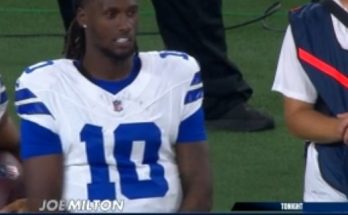When Jeremiah Smith stepped onto the field as a freshman at Ohio State, the buzz around him was already deafening. A five-star recruit, Smith had been touted as a generational talent, a wide receiver with the kind of rare athleticism and football IQ that doesn’t come around often. But what truly set him apart wasn’t just his ability to dominate on the gridiron—it was how he leveraged the new era of Name, Image, and Likeness (NIL) to redefine what it means to be a college athlete. His journey wasn’t just about securing endorsements; it was about building a brand, maximizing opportunities, and setting a blueprint for the next wave of student-athletes. And just when it seemed like he had reached his peak, Smith delivered an encore that solidified his status as a trailblazer in the NIL space.
From the moment NIL laws came into effect, Smith understood the assignment. While some athletes were content with signing a few local deals or promoting products on social media, he approached NIL with the same precision he brought to his route-running. His team—a mix of marketing experts, legal advisors, and his own sharp instincts—crafted a strategy that went beyond the typical endorsement. They sought partnerships that aligned with his personal brand, ensuring authenticity rather than just cashing checks. Early on, he inked deals with major sportswear brands, but what stood out was his collaboration with tech companies and lifestyle brands that resonated with his off-field persona. Smith wasn’t just selling products; he was selling a story—one of ambition, excellence, and the relentless pursuit of greatness.
What made Smith’s NIL journey unique was his ability to balance the demands of being a high-profile athlete with the responsibilities of brand-building. While some players struggled with the added pressure, he thrived. His social media presence was polished but genuine, offering fans a mix of behind-the-scenes football content, personal milestones, and carefully curated partnerships. He didn’t just post ads; he engaged with his audience, making them feel like part of his journey. This level of connection turned him into more than just a player—he became a cultural figure, someone whose influence extended far beyond the field.
But the real game-changer came when Smith decided to take control of his narrative in ways few athletes had before. Instead of waiting for brands to come to him, he launched his own ventures. A limited-edition merchandise line sold out in hours. A YouTube series documenting his freshman year amassed millions of views. He even partnered with a gaming company to create a signature in-game item, further expanding his reach into the digital world. These moves weren’t just about revenue; they were about ownership. Smith wasn’t just benefiting from NIL—he was shaping it, proving that athletes could be entrepreneurs as much as they were competitors.
Then came the encore. Just when it seemed like Smith had done it all, he announced a groundbreaking partnership with a major streaming platform for an exclusive docuseries. Unlike traditional sports documentaries, this project would be co-produced by his own media company, giving him creative control and a significant stake in the profits. The announcement sent shockwaves through the industry. Here was a college athlete, not even halfway through his eligibility, securing a deal that rivaled those of seasoned professionals. It was a testament to his vision and a clear signal that the landscape of college sports had irrevocably changed.
Critics wondered whether the distractions of NIL would affect his performance. Smith answered them the best way he knew how: by dominating on the field. His freshman season was nothing short of spectacular, with highlight-reel catches and game-winning plays that solidified his place as one of the most exciting players in the country. The synergy between his athletic success and his off-field ventures created a feedback loop—each touchdown bolstered his brand, and each business move seemed to fuel his competitive fire. He wasn’t just juggling football and NIL; he was excelling at both, proving that the two could coexist at the highest level.
Smith’s impact extended beyond his own career. His success opened doors for other athletes, showing them what was possible in the NIL era. High school recruits began factoring brand potential into their college decisions, and universities took note, investing more resources into helping athletes navigate this new world. The old model of amateurism was fading, and Smith was at the forefront, a living example of how modern athletes could take charge of their futures.
As his sophomore season approaches, the question isn’t whether Jeremiah Smith will continue to raise the bar—it’s how high he’ll set it next. His NIL journey has been a masterclass in innovation, ambition, and execution. He didn’t just adapt to the new rules of college sports; he rewrote them. And with each move, he reinforced a simple truth: the future belongs to those who see opportunities where others see limits.
The encore was never just about repeating success. It was about surpassing it. And for Jeremiah Smith, the next act promises to be even bigger.



